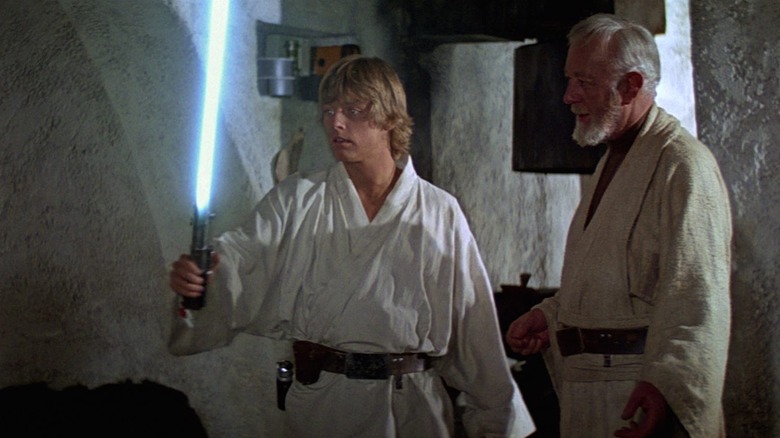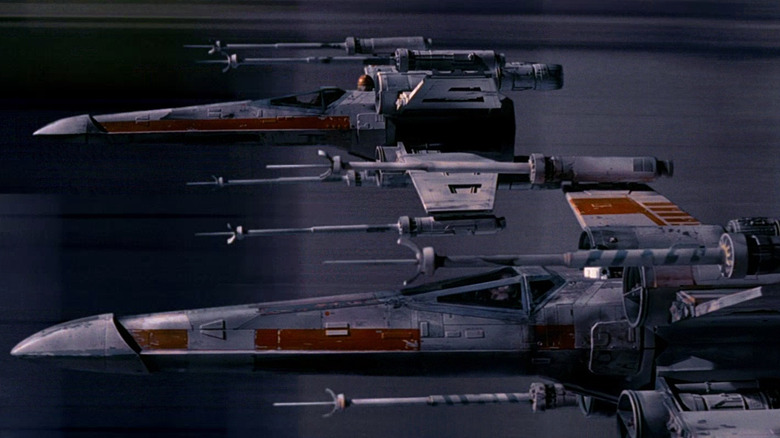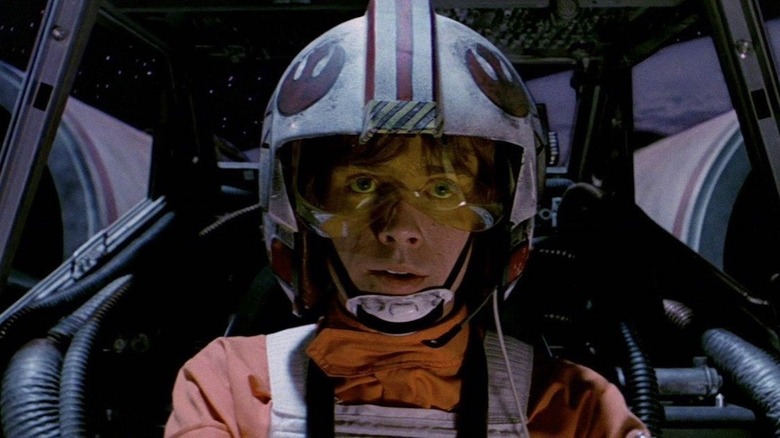George Lucas Committed To An Impossible Task For Star Wars' Earliest Special Effects
George Lucas had a bold vision when he set out to make "Star Wars" in the mid-1970s. He did not, however, have the technology to pull it off. No one did, at least not at an affordable price.
Douglas Trumbull had recently vaulted visual effects forward with his optical innovations for Stanley Kubrick's "2001: A Space Odyssey," but his photorealistic presentation of space was based wholly in physical reality. The space stations and ships in Kubrick's masterpiece drifted gracefully in the cosmos. Trumbull replicated this galactic ballet to eerie effect in his directorial debut "Silent Running," on which he employed an upstart technophile named John Dykstra, who was eager to build on Trumbull's inventions with a more dynamic application that would jar sci-fi flicks out of their reality-bound lethargy.
When Lucas commenced work on "Star Wars" (via a go-with-god greenlight from 20th Century Fox's Alan Ladd Jr.), he set up shop in Northern California and hit up the area's specialists for an expert special effects supervisor who could realize his dream of vintage war film dogfights in space. Trumbull might've been his go-to, but he wanted to continue being a director in his own right. This brought Lucas to Dykstra, and we don't get "Star Wars" without these two obdurate men joining forces.
Lucas didn't just make a movie, he made a visual f/x industry
Lucas was a mechanically inclined artist, but a bit of an untested autodidact when he set out to make "Star Wars." As he told J.W. Rinzler in the author's definitive "The Making of Star Wars:"
"I learned everything I could about special effects in school. I got the books and read everybody. But I hadn't worked very extensively with special effects and optical problems, and there aren't that many people around who know this kind of stuff anymore."
With Trumbull out of the picture, Lucas turned to Dykstra and conveyed his vision of a rollicking mainstream entertainment featuring state-of-the-art space skirmishes. "More than anything else, he wanted to get fluidity of motion," said Dykstra, "The ability to move the camera around so that you could create the illusion of actually photographing spaceships from a camera platform in space." Lucas gave Dykstra a visual illustration of what he wanted by showing him an eight-minute clip reel (cut down from 20-plus hours of footage) of aerial combat from black-and-white war flicks. "I would have the plane going from right to left," said Lucas, "And a plane coming toward us and flying away from us, to see if the movement would generate excitement."
Dykstra knew exactly how to do this. He just needed the go-ahead to build the camera that could pull it off. The technology was called "motion control," and the Death Star trench run wouldn't exist without it. Bringing it into existence was the trick.
Lucas is both a control freak and a homebody. Given his druthers, he'd probably never leave the San Francisco Bay Area. Unfortunately, Dykstra couldn't envision getting his motion control camera up to speed outside of Southern California. Lucas reluctantly trusted his newfound collaborator, and let him set up a laboratory in an abandoned Van Nuys warehouse.
'We were not known people'
One reason Lucas settled on Dykstra was that he was the only guy willing to risk his professional reputation on completing 350 complex optical shots in two years (a hugely ambitious undertaking considering that Trumbull needed three years to finish 205 f/x shots for "2001"). Dykstra had to reach out to unproven/unknown f/x artists to achieve his goal. One of these artists was future Oscar-winner Richard Edlund, who told Rinzler:
"Everybody said, 'It just can't be done in the time allotted.' But John had sold George on the idea that we could build the system that could do it. So John arranged to get a studio together out in the valley and build the system, which started with a camera that would be able to photograph something repeatedly through programming and motors that is, once you have the shot programmed, you can repeat that program over and over, as many times as you want, and then correlate information so that the shot can be done on a background for stars or a matte. So we proceeded to go ahead and build our systems. We were hideouts, in a way; we were not known people."
They're known now. Dykstra quickly fell out with Lucas, but cinema might very well look different in 2023 had they not come together for "Star Wars." Lucas, for his part, is still grateful. "John seemed to be the only one who was qualified and who was also interested in taking on the challenge," he told Rinzler. "A lot of the people who were qualified didn't want to have anything to do with it. They didn't think it could be done. They thought it was impossible for the kind of money we were talking about." If only they knew the kind of money they'd wind up making.


